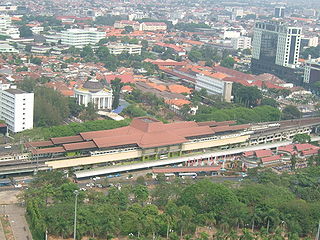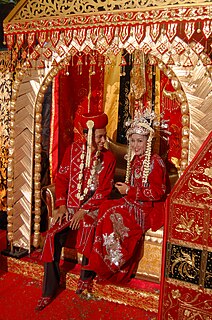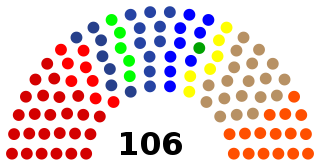
Bekasi is a landlocked city in West Java, Indonesia, located on the eastern border of Jakarta. It serves as a commuter city within the Jakarta metropolitan area. According to the 2020 Census by Statistics Indonesia (BPS), Bekasi had 2,543,676 inhabitants. The official estimate for mid 2021 was 2,564,940. It lies within the largest metropolitan area in Indonesia (Jabodetabek). The city is bordered by Bekasi Regency to the north and the east, Bogor Regency and Depok to the south, and East Jakarta to the west.

Gambir is a district of Central Jakarta, Indonesia. It is characterized by many historic buildings from the colonial era. It hosts some of the foremost political and learning/tourism features of the capital. The Merdeka Palace, the National Museum, the headquarters of the Indonesian Scout Movement and the Merdeka Square are among these.

Betawi people, or Betawis, are an Austronesian ethnic group native to the city of Jakarta and its immediate outskirts, as such often described as the native inhabitants of the city. They are the descendants of the people who inhabited Batavia from the 17th century onwards.

Pasar Minggu is a district of South Jakarta, Jakarta, Indonesia. The area is known for its traditional Sunday market, famous for the fruit market. Historically, Pasar Minggu is a fruit cultivation area developed by the Dutch government during the colonial period. The central point of the cultivation area is the traditional market of Pasar Minggu, located in what is now Pasar Minggu Kelurahan. Teak forest could also be found in Pasar Minggu district, notably around Jati Padang Kelurahan. Most of these areas has been converted into residential area as Jakarta grow southward.

Sawah Besar is a district (kecamatan) of Central Jakarta, Indonesia. Its neighborhoods are among the most historic, containing the 1820-established Pasar Baru, the new colonial city – Weltevreden – and the old course of the Ciliwung river. Landmarks include the Lapangan Banteng, the government's 19th century-built, low-rise A.A. Maramis Building and its high palmed-lawned vista, and Jakarta Cathedral.

Senen is a long-established urban district of Jakarta, Indonesia that has kept many tourist attractions such as two museums, the National Library of Indonesia and Gelanggang Remaja Senen, a quite narrow alley with old Chinese and similar style shops and restaurants. It was first developed in the 18th-century as Pasar Senen when governor Daendels established the bovenstad as the new center of government of the fledgling city. Its kernel remains in what is now the formal lower-tier Village/Neighbourhood of Senen, within, the others being Kwitang, Kenari, Paseban, Kramat, and Bungur. This article covers the archetypal core and the whole Subdistrict of Central Jakarta.

Jatinegara is one of the districts (Kecamatan) of East Jakarta, Indonesia. The name also refers to the larger, historic area of the colonial town of Meester Cornelis. Established in the 17th century, Jatinegara is one of the oldest areas in Jakarta, and contains a number of buildings from the colonial period.
Makasar is a district (kecamatan) of East Jakarta, Indonesia. It had an area of 21.85 km2 and population of 185,830 at the 2010 Census; the latest official estimate is 204,595.
Pasar Rebo is a district (kecamatan) of East Jakarta, Indonesia. The boundaries of Pasar Rebo District are the Ciliwung to the west and north; and Bogor Raya Road and Cipinang River to the east. The city of Depok is located to the south of Pasar Rebo District.
Jagakarsa is a district of South Jakarta, one of the administrative cities in Jakarta Indonesia. Jagakarsa is the southernmost district of South Jakarta Jagakarsa District is bounded by Ciliwung River to the east, Krukut River to the west, and Margasatwa-Sagu-Joe-T.B.Simatupang-Poltangan Road to the north, while the boundary marches with Depok city to the south.
Koja is a subdistrict of North Jakarta, Indonesia. It is known as the location of Kampung Tugu, a historic Portuguese-influenced neighborhood in North Jakarta.
Cawang is an administrative village at Kramat Jati subdistrict, East Jakarta. The borders of Cawang are:
Kwitang is an administrative village (kelurahan) in the subdistrict (kecamatan) of Senen, Central Jakarta. It is one of the historic administrative village of Jakarta. The boundary of Kwitang is the Ciliwung to the west, Jalan Kramat Kwitang to the north, Jalan Kramat Raya to the east, and Jalan Kramat 4 to the south.

The Special Capital Region of Jakarta Regional People's Representative Council is the unicameral legislature of the Indonesian province of Jakarta. The Council is composed of 106 members elected via party lists in the 2014 legislative election. Elections are held every five years and are conducted simultaneously with the nationwide legislative election.
Batavia Castle was a fort located at the mouth of Ciliwung River in Jakarta. Batavia Castle was the administrative center of Dutch East India Company in Asia.
Professor Yasmine Zaki Shahab, S.S., M.A., Ph.D. is an Indonesian anthropologist. In addition, her interest in Betawi society made her actively doing research and writing the topic about that. To date, Shahab is still active in some matters relating to Betawi culture.

Raden Sjamsuridjal, sometimes written Syamsurizal, was an Indonesian politician who served as the Mayor of Jakarta between 1951 and 1953. Before becoming Jakarta's mayor, he had been mayor of Bandung and Solo.

Raden Soediro was an Indonesian politician who served as the first Governor of Jakarta, between 1958 and 1960. Prior to becoming Governor, Soediro served as Jakarta's mayor for five years until the city was made its own special capital region. Soediro was also Governor of Sulawesi between 1951 and 1953.

Sayyid Abdullah bin Alwi Alatas was a Dutch East Indies merchant, landlord, and philanthropist of Arab descent from the Ba 'Alawi sada clan. Alatas is also the owner of the Cikini House after it was bought from Raden Saleh. He also inherited another eccentric house, such as a house built by a Frenchman in an Islamic style.










